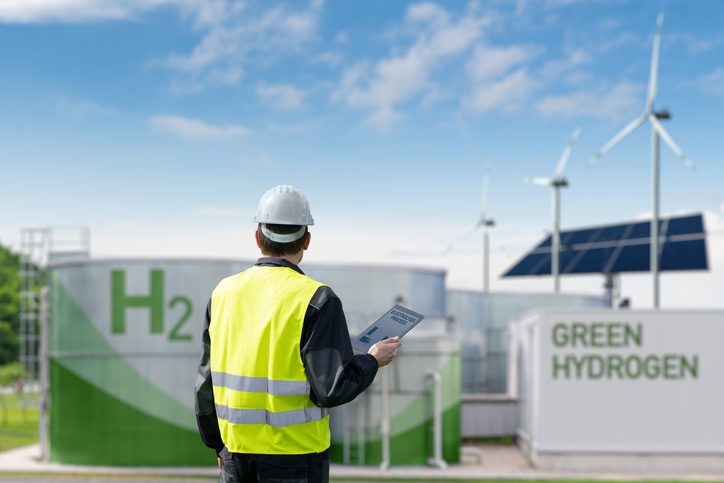

The federal government has introduced its long-awaited hydrogen production tax credit Bill to Parliament, but it faces a tricky job getting the industry-supported legislation approved in the last week of parliament for the year.
The headline tax incentive is the $2/kg credit for green hydrogen produced between 2027–2028 and 2039–40. The closing deadline is a year earlier than the one proposed in the May Budget papers.
The credit will last for up to ten years per project.
The move, a delayed counterpoint to similar efforts such as the US Inflation Reduction Act (IRA) and the EU’s Hydrogen Bank, is expected to help make green hydrogen financially viable to produce domestically.
“This legislation provides industry the clarity and certainty it needs to invest in Australian renewable hydrogen and critical minerals projects with confidence,” said a statement issued by treasurer Jim Chalmers, energy minister Chris Bowen, and future made in Australia minister Tim Ayres.
“Recipients of the production tax incentives will also be required to deliver benefits relating to the six Community Benefit Principles.”
But the Bill is opposed by the Coalition, with leader Peter Dutton snubbing it as “billions for billionaires” despite support from his state counterparts.
In the Senate the Greens remain unconvinced and there is a mix of views among independents.
Yet Clean Energy Council decarbonisation policy director Anna Freeman expects strong support in the Senate, despite lukewarm support when the legislation was first revealed in May.
A rejection of this legislation would be “a very sad outcome” for Australia.
“If we don’t support initiatives like the Production Tax Credits bill, we will struggle to see the development of a large-scale and competitive hydrogen production sector in Australia in the next decade, and that will close the door to a range of new processing and manufacturing opportunities in renewable fuels and green metals,” she told Renew Economy.
What the Bill does have is broad industry support and a tax credit rider for critical minerals, both of which will make the Coalition’s position, at least, unpopular.
The rider is a production tax credit for 31 critical minerals, covering 10 per cent of the processing and refining costs for anything made between 2027–28 and 2039–40, again for up to ten years per project.
The Association of Mining and Exploration Companies has already been pressuring the Coalition over its mixed messaging about support for mining but lukewarm support for the critical minerals tax credit.
AMEC CEO Warren Pearce listed the benefits of the Bill as more well-paying jobs, more tax and more royalties for governments, and said it was just what industry had asked for in comments to The West Australian newspaper over the weekend.
And Chamber of Minerals and Energy WA CEO Rebecca Tomkinson wants the bill passed quickly, as the state is competing hard for the rising green resources economy.
Australia’s once hopeful green hydrogen industry has been floundering as other countries’ offers were too good to pass up.
Billionaire climate convert Andrew Forrest moved his first projects to the US last year while continuing to campaign for a reason to get projects off the ground at home. And the big hopes for a Tasmanian hydrogen hub appear to have died off completely.
Freeman says while the economics of renewable hydrogen projects in Australia is very challenging and the new credit won’t completely close that gap, it does offer a pathway to viability over time.
“This is a long-term play for Australia to capture a share of a large emerging market. Scaling up our sector will take many years and as such it is vital that we get started now,” she says.
“Global demand for clean hydrogen is still emerging, but it’s clear that with the range of decarbonisation commitments being made by governments and industries, the market will grow and could quickly outstrip supply.
Australia’s competitive advantage will be in using green hydrogen for industrial processes rather than as an export via ammonia, says The Superpower Institute chair Rod Sims.
“Hydrogen is needed for its chemical properties as a key enabler of producing green iron, green fertiliser and green shipping and aviation fuel and is central to decarbonising many sectors that cannot decarbonise through electrification,” he said in a statement.
“Australia is set to gain some $700 billion in export opportunities from green exports such as green iron. This is over five times the usual value of our coal and gas exports.”
What the new legislation will do is bring the price down to where other countries have done so to create a market for the final products, levelling the global playing field for green hydrogen.
Wind and solar farm output jumped 12% in March quarter from the same period last…
Engie's Laura Caspari explains why batteries are paired better with solar than wind, and why…
Italian and Japanese joint venture declares Australia is the "place to be" for renewables after…
Tuvalu climate minister says Coalition plans to abandon bid to co-host COP31 creates "uncertainty" and…
Coal’s “very slow death” is well and truly underway, with 2024 data revealing the lowest…
Large wind project returns to the planning portal after a six year hiatus with fewer…